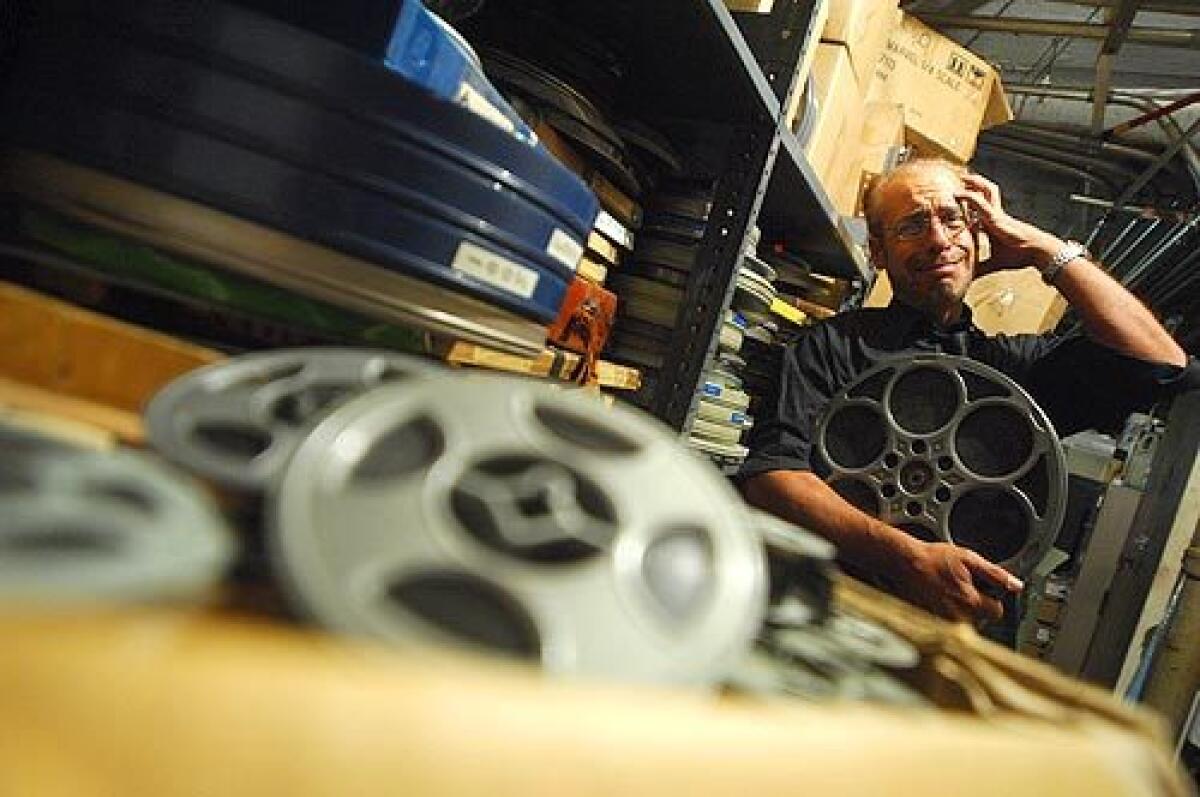Golden Era TV meets the Digital Age

OLD-TIME television is making a comeback. Not on television, though.
Aided by the neutron star-like cultural gravity of Google’s YouTube, an increasing number of vintage TV programs and early commercials are flying out of collectors’ closets, ending half a century of exile from the small screen.
For members of Generation X-Box, it’s a chance to see what prehistoric television looked like, back when it was barely more than “radio with pictures.” Fifty-year-old TV commercials conjure a distant era, when Heinz ketchup was more than a condiment (“when the recipe calls for tomato flavor ”) and Cocoa Puffs delivered not just sugar but “chocolate-flavored energy.”
Retiring boomers can also find shows they last enjoyed as decoder-ring-wearing youths. In forgotten 1950s sci-fi serials like “Captain Midnight” and “Rocky Jones, Space Ranger,” the pseudo-science is not all that’s quaint. (When Vena tells Rocky there’s a UFO approaching the rocket ship from 2 o’clock, Rocky chides, “Are you positive, or is this merely a woman’s intuition?”)
Indeed, as television collectors large and small continue to digitize and upload thousands of rare old film reels and videotapes, YouTube is threatening to become a repository of television history that could rival the nation’s leading broadcast museums, both in the scope of its offerings and in the number of people it can reach.
Ron Simon, curator of the Paley Center for Media (formerly the Museum of Television and Radio), said that collectors have traditionally been very possessive, preferring to keep their archives out of the public view. But with the arrival of video sharing sites, that mentality is changing. “YouTube has encouraged the whole collector community to put examples of their material out there,” he said.
With this YouTube-based resurrection, however, has come not just nostalgia but a set of legal questions as tangled as a reel of tape that’s come off its spool.
For one thing, a Dickensian legal impasse arises when a collector owns a piece of one-of-a-kind footage that’s still under copyright. In a case like that, the collector owns the footage, but not the rights, while the rights-holder owns the rights but not the footage.
Ask Ira Gallen, a New York City TV buff who has built one of the largest private collections of early television commercials and Golden Era programming in the nation and is rushing to get as much of his 10,000-piece collection onto YouTube as he can before it disintegrates.
Many of the old programs in Gallen’s collection, especially the variety shows, are filled with copyrighted music and songs and thoroughly infused with advertisers’ messages.
Take “The Frank Sinatra Show,” which ran on CBS from 1950 to 1952. Because the show was live and never intended for rebroadcast, the creators may not have explicitly copyrighted it. But many of the episodes feature Sinatra crooning alongside the likes of Perry Como, Frankie Laine and Rudy Vallee. Any performances of these songs are still owned by either the record companies or the singers’ estates, neither of which likes to see Frank doing pro bono work on YouTube. The Sinatra estate alone makes hundreds of takedown requests every month.
Moreover, many of the brands from these old programs are still trademarked. The only difference is they’re now owned by conglomerates that gobbled up old-time companies.
The vitamin supplement Geritol, which once touted itself as a tonic for “tired blood,” sponsored an array of ‘50s shows, including “To Tell the Truth” and “Ted Mack and the Original Amateur Hour” — which Gallen has put online. Geritol was made by J.B. Williams, later bought by Nabisco, then sold to Beecham, which eventually merged with what is now GlaxoSmithKline, whose legal department, from the looks of it, is the size of Iowa.
Gallen, a writer and director who makes money licensing his footage to brand owners and media outlets, does worry that rights hounds will come after him for showing protected material without asking. He’s already gotten complaints from the Sinatra estate and Major League Baseball, he said. But if he’s going to sell off his collection, YouTube is the best way to advertise what he’s got. So infringement risks are just the cost of doing business.
“I own stuff that people own the rights to, and they don’t even know it exists,” Gallen said. “I’m just hoping the copyright holders will call me before they shut me down.”
Other enthusiasts take a more laissez-faire approach to posting their collections online. Jeff Macauley, 46, of New York City has a collection of 150 television episodes featuring Dinah Shore. Over eight months, he’s uploaded most of his Shore-related footage onto YouTube, none of it with permission.
“The technology is there, and it’s easy to do,” he said. “Just someone shaking their finger at me and telling me I can’t do it — I don’t see the point. They have to figure out another way.”
Pirates or princes?
WHETHER these collectors are operating on solid legal ground or not, most TV historians agree that without them, there would be little footage to quibble over in the first place.A great deal of television’s early period is simply gone forever. Many of the first programs were broadcast live, and with video still a decade off, the shows were never even recorded. In cases where stations wanted to show live programs in areas beyond the broadcast radius, they resorted to making crude recordings called kinescopes, where a film camera was literally placed in front of a television set as the show played.
But kinescopes were meant for one-time syndication to network affiliates, not for archiving. The bulky film reels stacked up quickly, and because the stations had no financial incentive to keep them around, the canisters were thrown away.
In the 1950s and ‘60s, and even into the ‘70s, said Steve Jajkowski, a curatorial advisor for Chicago’s Museum of Broadcast Communications, stations and production companies were not overly preoccupied with keeping their material around. “Back then, they figured nobody was going to watch this stuff again. If it was rerun, it was rerun once. Then it was tossed.”
One horrific story concerns the fate of the archive from New York’s historic DuMont network, an early competitor to NBC, ABC and CBS. In 1996, Edie Adams, the wife of Golden Era TV comedian Ernie Kovacs, testified to the Library of Congress that when DuMont was sold in the early 1970s, there was a question as to who would bear the expense of storing the old footage.
According to Adams, one lawyer said he’d “take care of it.” “The next morning he had three huge semis back up to the loading dock at ABC, filled them with all the stored kinescopes and dumped them in Upper New York Bay!”
In a climate as history-hostile as this, it was up to dumpster divers, flea market collectors and TV insiders who “borrowed” footage for their own collections to rescue early television from oblivion.
In this sense, packrat collectors like Gallen occupy a strange middle ground between hero and profiteer. Many of them want to cash in on their material, whereas the academic crowd believes that a purist would donate his collection to the museums. (In fact, Gallen has donated many of his commercials to the Paley Center.)
But Gallen would tell you he hasn’t spent 30 years collecting film prints and video cassettes — not to mention the countless hours he’s spent cataloging, digitizing and uploading — so he could give it all away for free.
He says he’d happily part with his collection for about $10 million, and then maybe another $10 million to oversee the transfer process. “That’s not too much to ask, right?”
But is there anyone who will pay millions for a basement full of historical curiosities? From the nonprofit sector, probably not. As Gallen himself points out, “There’s no major funding to save early television.” The Paley Center, located in New York and Beverly Hills, deals strictly in donations and already has its hands full maintaining its 140,000-piece collection.
Whether the television companies would be interested is a matter of doubt among experts. “There’s no impetus for the networks to have their own broadcasting archive” when there are already several major museums and universities doing the job for them, said Simon, the Paley Center’s curator.
So Gallen, a kind of one-man museum, has been handling the work himself. “I’m running on fumes,” he said. In the nearly nine months he’s been putting videos online, he’s uploaded more than 3,000 clips to his 13 YouTube channels, including youtube.com/tvnetworks. “What I’ve got up there now is just the tip of the iceberg.”
He still has thousands more clips to post, and closets full of reels and tapes — perhaps 5,000 of them — that he has yet to begin cataloging. Much of his collection is stored in his New York basement, and because the room is not temperature controlled, the footage is vulnerable to the elements. Some of it has already begun to decompose. “The whole collection needs saving,” Gallen lamented.
Though Gallen touts his operation as “the official video network for baby boomers,” you don’t have to be a historian to see that his collection has more than sentimental value. Golden Era TV is a document of a medium in its infancy: bad lighting, klutzy writing and paper bag acting abound — even Sinatra and Como stutter their way through awkward dialogue and moronic laugh lines.
Other shows, like 1954’s “Captain Midnight,” are such self-parodies that no “Mystery Science Theater”-type snark is necessary. The episode titled “Deadly Diamonds” begins with this back-and-forth between Captain Midnight, who’s fiddling with a boxy-looking receiver of some kind, and his sidekick Ichabod Mudd:
“Say, what is that gadget?”
“That, Ikky, is an Omni Counter.”
“What does it do, count Omnis?”
“Precisely.”
(When he hears the Omni Counter can “detect the presence of all minerals by counting their rate of radiation,” the obviously Jewish Ikky asks if the device can find gold. “Among other things,” the Captain replies with a note of disdain.)
Gallen admitted he wasn’t sure exactly who owned the rights to “Captain Midnight.”
Though many of Gallen’s YouTube clips still have fewer than 100 views, people have begun to notice the collection. He is now receiving more than 200 e-mails per day through his YouTube account.
He’s also had some initial luck attracting brand owners. He said he had been approached by the companies that own Milton Bradley, Geritol, Excedrin, Bonomo’s Turkish Taffy and Borden’s dairy products. Gallen charges $2,500 to $3,000 per commercial — a steal, if you ask him.
Another of Gallen’s promotional gambits is to challenge viewers to help identify the actors in the long-lost clips he’s posted.
“Were [sic] are these dancers today? Who are they?” blares a tagline on a 1953 episode of “The Colgate Comedy Hour,” hosted by Jimmy Durante, as the leggy chorus line girls do high kicks in the foreground.
Amy Sheldon, 61, daughter of the 1950s-era kids show emcee Herb Sheldon, said she found out about Gallen when her own daughter was surfing the Web for information about her grandfather, whom she never knew. Gallen had posted a 30-minute clip of Sheldon hosting the children’s variety show “Wonderama.”
Sheldon, who owns next to no footage of her father’s 10 years in television — much of it took place in the kinescope era or before — wrote to Gallen to ask if she could get a copy of the program for her family.
“It’s really funny how it all comes together,” she said.
--
david.sarno@latimes.com
More to Read
The biggest entertainment stories
Get our big stories about Hollywood, film, television, music, arts, culture and more right in your inbox as soon as they publish.
You may occasionally receive promotional content from the Los Angeles Times.










